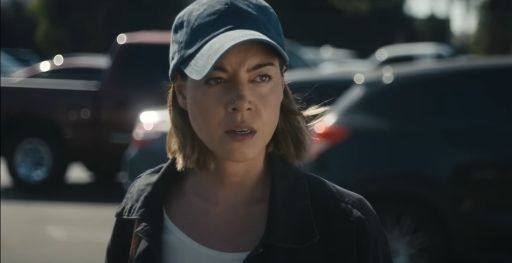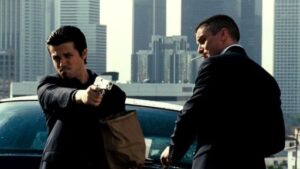The journey of the title character into the criminal underworld is followed in the crime thriller film “Emily the Criminal.” When Emily’s student loans start to mount, she looks for work in various places. But because of her minor criminal history, the process is challenging, and she has few options. Emily turns into a dummy shopper in her desperate attempt to pay off her debt and begin leading a fulfilling life. Her crimes increase in size as the story goes on until she commits them to an extreme.
The film, which was directed by John Patton Ford, shows how unfair systemic practises unintentionally breed criminals. The movie makes observations about issues like debt, capitalist practices, and the brutality of society. The plot includes common clichés like a good person going bad, characters succumbing to their circumstances, and more. If you enjoy this type of storytelling, we have a list of movies selected for you. The majority of these movies like “Emily the Criminal” are available on Netflix, Hulu, or Amazon Prime.
Body Brokers (2021)
The thriller “Body Brokers,” written and directed by John Swab, is about an illegal operation carried out by a foundation that is supposed to aid drug addicts. Utah, who has a drug addiction, checks himself into a rehab facility in the hopes of getting better and beginning a new life. He soon learns that the centre is merely a front for a significant fraud. The foundation promises to treat the addicts it accepts, but instead, these individuals end up becoming recruiters who bring in more people who are just like them, and the cycle continues.
Similar to “Emily the Criminal,” “Body Brokers” demonstrates how capitalism frequently ruins lives and drives people to the brink. It clarifies how, occasionally, someone fighting the system loses everything—including their life—or becomes a criminal in order to survive. Utah from the second film is comparable to Emily from the first. Despite the fact that the two have different issues, they follow a similar course of action to resolve all of their issues and attempt a fresh start.
Cassandra’s Dream (2007)
In the Woody Allen film “Cassandra’s Dream,” two brothers get into a lot of debt and resort to crime to pay it off. Colin Farrell’s character Terry (played by Ewan McGregor) loses a lot of money gambling when things are going well for him and Terry. The two contact their uncle Howard, who agrees to give them the money they desperately need in exchange for killing someone for him. Without understanding how their decision will alter their lives forever, the brothers concur.
In both “Cassandra’s Dream” and “Emily the Criminal,” debt plays an important part and serves as the main plot device. The circumstances of Terry and Ian are similar to those of Emily, and all three characters make similar errors. But Terry and Ian resemble the brothers in “Emily the Criminal” who own the dummy store. Both times, there is too much money and risk, which causes conflict between the brothers. The four characters show how bonds and relationships are irrelevant in situations involving significant sums of money and stakes.
Good Time (2017)
In the crime thriller “Good Time,” starring Robert Pattinson, two brothers named Nick and Connie are the central characters. When the two attempt to loot a bank, Nick is apprehended and imprisoned. Connie embarks on a reckless rampage, taking on various jobs that will allow him to earn enough money to bail out his brother Nick. In comparison to “Emily the Criminal,” “Good Time,” directed by Josh and Benny Safdie, gives the audience a closer look at the criminal underworld.
Although the characters of Connie and Emily follow similar paths, they are from very different worlds. The similarities between the two characters grow as Emily starts her own dummy shopping company. In general, both movies look at themes like loneliness, desperation, and the real nature of society.
Harsh Times (2005)
In the action movie “Harsh Times,” Christian Bale plays Jim, a former soldier with PTSD who is trying to find work in the police force. Jim, however, becomes furious and decides to enter the criminal underworld after failing the psychological profile test. The film, which was written and directed by David Ayer, explores the mind of a person who longs for something but is unable to obtain it. Jim envisioned marrying his girlfriend and starting a family while working a secure law enforcement job because, to him, doing so would provide a chance for normalcy.
As a result, when Jim turns into a criminal, he finds himself on the other end of the spectrum. Similar to Jim, Emily from the John Patton Ford film has lofty goals and aspirations for the future. However, her debt stands in the way. She embarks on a perilous path in an attempt to solve her problems, but she soon turns criminal. The parallel storylines of Emily and Jim allow us to see how desperate people will go to any lengths to achieve their goals.
Hell or High Water (2016)
In the novel “Hell or High Water,” two brothers named Toby and Tanner struggle mightily to save their family property. So they loot banks and embark on a risky journey. The main theme of the David Mackenzie-directed film is how poverty deprives people of their most fundamental needs. Tanner and Toby make the decision that they will not be constrained by their circumstances but will instead overcome them.
The two brothers share Emily’s desire to be in control of her circumstances and avoid letting her loan define her. To meet her demands, Emily uses credit card fraud while the brothers loot banks. Although the two films have different tones, they both have a similar central theme that keeps viewers interested until the very end.
Plastic (2014)
In the action movie “Plastic,” a group of college students run a credit card scam but soon find themselves in trouble after robbing a dangerous and powerful person. To get out of this jam, the group decides to pull off their biggest con by going after a larger target. The credit card scam unites them even though “Plastic” has a different tone from “Emily the Criminal” in terms of plot.
While “Plastic” portrays it in a fashionable and glitzy way, “Emily the Criminal” shows the operations in a way that is more accurate. When the students run into trouble, the stakes, however, become very real. Like Emily, who understands that the only way to solve a problem is to get into a bigger one, the group decides to rob a more prominent person. Both of these films deal with crime in different ways, but the characters have some similarities and show how people behave when put in a difficult situation.
The Lookout (2007)
The crime thriller film “The Lookout,” written and directed by Scott Frank, centres on Chris (Joseph Gordon-Levitt), who struggles to keep a steady job at a bank. Chris used to be a great athlete with a bright future, but an accident prevents him from realising his goals. He also has short-term memory loss, which makes it challenging for him to lead a normal life. Chris gets himself caught up in a bank heist after a chance encounter sends him down a dangerous path.
In the film, it is explored how quickly everything can change. Despite his unfortunate circumstances, Chris seems to be adjusting well to his new life. Christ doesn’t seem as eager to regain control of his life and reach his objectives as the title character in “Emily the Criminal.” Chris still harbours unresolved emotions that are hidden deep within of him and yet yearns to be a carefree athlete. These feelings prompt him to commit the bank heist. Chris and Emily eventually find themselves in a scenario where they must confront their choices and decide what to do next.
The Place Beyond the Pines (2013)
In the Derek Cianfrance-directed film “The Place Beyond the Pines,” stunt rider Luke Glanton (Ryan Gosling) begins robbing banks to support his girlfriend and their infant child. Avery Cross (Bradley Cooper), a new police officer, becomes aware of Luke’s activities and attempts to apprehend the thief despite operating in a corrupt system.
Stories like “The Place Beyond the Pines” and “Emily the Criminal” feature characters whose decisions are influenced by their environment. The films make us feel sorry for the main protagonists, Luke and Emily, and occasionally even make us want to cheer for them. The two movies make comments about the systems they depict in addition to these other aspects. Emily the Criminal, directed by Derek Cianfrance, examines law enforcement corruption in addition to student loans and unfair hiring practices.









